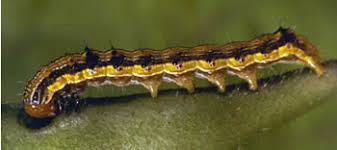GROWERS are being encouraged to rally behind an industry push to preserve the efficacy of insecticides to control Helicoverpa armigera in pulse crops.
The alternative is an unpalatable and potentially costly one – an escalation of insecticide resistance in Helicoverpa species across production regions, leading to poor levels of control, increased sprays and a reduction in chemical options.
Insecticide resistance in Helicoverpa species poses a threat to successful pest control and economic crop production in Australia, prompting the recent release of a H. armigera resistance management strategy (RMS) for the northern cropping region.
Developed by the National Insecticide Resistance Management (NIRM) group, part of the GRDC-investment Grains Pest Advisory Committee (GPAC), the RMS aims to minimise selection pressure for resistance to the same chemical groups across consecutive generations of H. armigera.
H. armigera has already evolved some level of resistance to at least three chemical groups with broad spectrum activity (organophosphates, carbamates and pyrethroids) which represent the majority of the 200 chemicals registered for the pest in Australia.
In recent years, a move towards using more selective products to target H. armigera has proved invaluable in protecting our pulse crops. However, these selective products are now coming under strong pressure for resistance development.
Queensland Department of Agriculture and Fisheries (DAF) senior entomologist Melina Miles urges growers to assess the full range of options available for Helicoverpa control in chickpeas, mungbeans and soybeans and determine what product can be used if a second spray is required.
“Chickpeas and mungbeans are currently, and for the foreseeable future, the most valuable grains crops influenced by the RMS and therefore the strategy is primarily focused on insecticide Modes of Action (MoA) rotation in these systems,” Dr Miles said.
“It’s built around product windows for Altacor (chlorantraniliprole) and Steward (indoxacarb) because Altacor is at risk from over-reliance in pulses, although resistance frequencies are currently low, and Steward® is at risk due to genetic predisposition (high level genetic dominance and metabolic mechanism) and pre-existing levels of resistance in New South Wales and Queensland.
“At the same time, the use of indoxacarb in pulses is expected to increase as generic products come on to the market.
“In future, the RMS may include windows for other products such as Affirm (emamectin benzoate), Success Neo (spinetoram), and other new products that come to market if their use patterns necessitate management.”
Two regions have individual RMSs, each designed to highlight the most effective products available when they are of greatest benefit, whilst minimising the risk of overuse.
The regions are: Northern Grains Region which incorporates the Belyando, Callide Central Highlands and Dawson; and the Central Grains Region incorporating the Balonne, Bourke, Burnett, Darling Downs, Gwydir, Lachlan, Macintyre, Macquarie and Namoi.
“The RMS provides windows-based recommendations common to southern Queensland, central and northern NSW because H. armigera moths are highly mobile and have the capacity to move between these regions,” Dr Miles said.
“This potentially increases the risk of further exposing populations of H. armigera previously selected for resistance in other areas.”
To avoid repeated use of either Steward or Altacor within the use window, Dr Miles said the RMS limited the number of allowable applications to one per crop, which in some instances may differ from the label registration.
However, she said the RMS recommendations were developed in consultation with the chemical companies and the RMS has been endorsed by CropLife Australia.
Sources: GRDC, QDAF
For more information on the strategy, download a copy of Dr Miles’ Update presentation from the Research and Development section of the GRDC website www.grdc.com.au or click https://bit.ly/2siZuSv.
To download a copy of the RMS fact sheet, click https://bit.ly/2QxHoWl. To listen to the GRDC podcast with Melina Miles go to https://grdc.com.au/news-and-media/audio





HAVE YOUR SAY